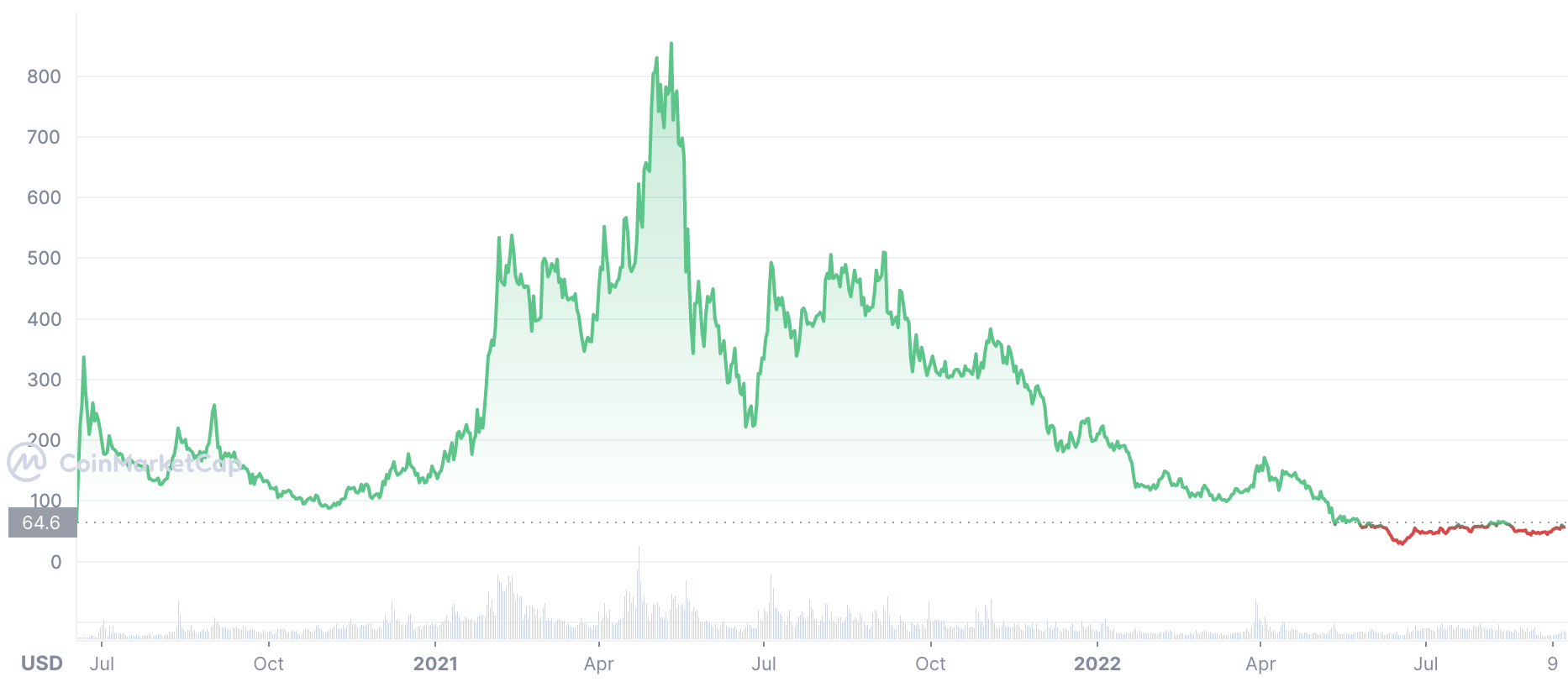Compound coin price prediction: Can COMP buck the bearish crypto trend?
We look at the Compound decentralised finance (DeFi) lending protocol and the outlook for its COMP token
The Compound cryptocurrency token (COMP) has started to recover from a long-term bearish trend, and was up 9% over the past seven days as of 16 September 2022.
This price boost followed the announcement that Compound would now offer borrowing options to institutions, bringing larger clients to the crypto platform.
What is Compound coin and how does the protocol work? Can the price continue to rebound, or is it a ‘sell’? In this article, we look at the latest news on the project and expectations for the future direction of the price to help inform your trading decisions.
What is Compound?
Compound is one of numerous interest-rate protocols that have emerged with the growth of decentralised finance (DeFi) applications on blockchains.
Compound is an autonomous, algorithmic protocol that runs on the Ethereum (ETH) blockchain. The project was created in 2017 by Robert Leshner and Geoffrey Hayes, who previously worked at online food delivery firm Postmates. Leshner is CEO of Compound Labs, which develops the protocol, and Hayes is its chief technology officer (CTO).
Compound aims to offer cryptocurrency users an equivalent to the money-market accounts available in traditional finance, where investors receive a return on their deposits.
Compound offers lending pools where users can deposit their funds or borrow money using their crypto as collateral, enabling them to earn interest in return. Within each pool, lenders earn half the distribution and borrowers earn the other half.
The Compound token
Compound token holders can debate, submit and vote on proposals for changes to the protocol without the Compound team needing to be involved. This process can be used to determine which cryptocurrencies to support, and the various collateralisation factors and token distribution rules. It can also be used to implement upgrades to add new functionality.
COMP is the protocol’s governance token, which runs on Ethereum’s ERC-20 standard. There are currently more than 7.2 million COMP tokens in circulation out of a maximum supply of 10 million. Approximately 1,139 COMP tokens are distributed to users daily. The distribution is allocated to each liquidity pool and set by holders of the COMP token.
Token holders can delegate their voting rights to any wallet address. Wallets that hold at least 100 COMP tokens can create an autonomous proposal and wallets that hold 25,000 COMP are permitted to create governance proposals.
Protocol changes take at least a week to implement, as there is a two-day review period for governance proposals, after which there is a three-day voting period. If the majority of votes reaches at least 400,000, the proposal is queued and can be implemented two days later.
The Compound protocol is designed to ensure that risk is limited by a liquidation function that keeps the amount a user borrows below their borrowing capacity.
The whitepaper continued: “Any Ethereum address that possesses the borrowed asset may invoke the liquidation function, thereby exchanging their asset for the borrower’s cToken collateral. As both users, assets and prices are all contained within the Compound protocol, liquidation is frictionless, and does not rely on any outside systems or order books,” the document adds.
DeFi lending offers users the ability to access funds without selling their assets, and creates opportunities for consumers, traders and developers, including:
-
Borrowing tokens to use in the Ethereum ecosystem without waiting to fill an order or off-chain activity
-
Financing new investments, such as in initial coin offerings (ICOs), using the investor’s portfolio as collateral
-
Profiting from shorting a token by borrowing and selling it on an exchange.
Compound has become the ninth-largest DeFi protocol based on total value locked (TVL), with a value of more than $2.11bn, according to data compiled by DeFi Llama. That puts it ahead of popular apps like SushiSwap (SUSHI) and Yearn Finance (YFI).
COMP price holds up as crypto prices retreat
The COMP price chart shows the token gained 33.3% in 2021 as it spiked from the $149 level to a high of $531.98 in May, then dropped back to $200 at the end of the year.
The price moved up to $242.94 on 5 January 2022, but then declined to $94.13 on 24 February as cryptocurrency markets lowered along with the financial markets. The price began to rebound in March and reached $173.91 on 3 April, as the markets attempted to rebound. But another sell-off took the price back down to $117.48 on 11 April 2022.
The price briefly bounced up to the $140 range after trading platform Robinhood (HOOD) listed the token for trading from 12 April, along with Polygon (MATIC), Shiba Inu (SHIB) and Solana (SOL).
The coin then fell victim to the crypto crash that saw COMP drop to its all-time low of $26.52 on 18 June 2022.
In recent Compound crypto news, the protocol introduced borrowing options for institutions on 14 September 2022. An official Medium post said: “Starting today, to meet the growing demand for liquidity, institutions can now borrow from Compound Treasury, using digital assets as collateral.”
It has gained slightly since its June low. As of 16 September 2022, it was trading at $57.00, up 9% over the past seven days.
COMP/USD price chart, all-time performance
 Source: CoinMarketCap
Source: CoinMarketCap
How is the COMP coin likely to trade in the future? Read on for the latest Compound price predictions.
Compound coin price prediction: Short-term COMP outlook
Technical analysis on the COMP token from CoinCodex on 16 September said there was a neutral sentiment, with 10 indicators showing ‘sell’ signals and 16 ‘buy’ signals. Meanwhile, its fear and greed index displayed ‘extreme fear’.
The site’s Compound crypto price prediction indicated that the token could be trading at $63.13 by 14 October.
What do longer-term forecasts say about Compound’s potential as an investment?
Compound coin price predictions: 2022, 2025, 2030
The long-term COMP crypto price prediction from algorithm-based forecasting site WalletInvestor was bearish as of 16 September 2022, projecting that the value of the coin could plunge to $3.13 in a year.
The website’s Compound crypto price prediction showed the price would continue to fall and stoop to $1.02 at the beginning of 2027.
The Compound coin forecast from PricePrediction was bullish, anticipating that the price could rise in 2022 to average $61.05, based on deep artificial intelligence (AI)-assisted technical analysis.
The website’s Compound coin price prediction for 2025 listed an average price of $204.34. The platform’s outlook for the token in 2030 saw it rocketing to an average value of $1,272.74.
DigitalCoinPrice was more reserved but still bullish in its long-term COMP coin price prediction, estimating that it could average $74.85 in 2022, based on historical data. By 2025, the COMP prediction indicated the price could average $229.35. The site’s Compound coin price prediction for 2030 saw it more than doubling to average $794.61.
CoinPriceForecast’s Compound coin price prediction for 2022 saw the token trading at $63.25 by year-end. The platform’s Compound coin price prediction for 2025 saw the token trading at $80.98 in the middle of the year. Over the longer term, CoinPriceForecast expected the token to grow to $140.11 by December 2030.
When evaluating a COMP price prediction, it’s important to bear in mind that cryptocurrency markets remain extremely volatile, making it difficult to accurately estimate a coin’s target price in a few hours, and even harder to give long-term predictions. As such, analysts and AI-based forecasters can and do get their COMP coin price predictions wrong.
If you are considering investing in cryptocurrency tokens, we recommend that you always do your own research. Look at the latest market trends, news, technical and fundamental analysis, and expert opinion before making any trading decision. Keep in mind that past performance is no guarantee of future returns.
FAQs
How many Compound coins are there?
There are currently about 7.2 million COMP tokens in circulation out of a maximum supply of 10 million.
Is Compound a good investment?
In highly volatile cryptocurrency markets, it is important to do your own research on a coin or token to determine if it is a good fit for your trading portfolio. Whether the COMP token is a suitable asset for you will depend on your risk tolerance and how much money you intend to trade. Never invest more than you can afford to lose.
Will COMP go up or down?
The direction of the COMP coin price will depend on price trends in the broader cryptocurrency markets, as well as the development and adoption of the Compound protocol.
Can the COMP coin reach $500?
Forecasting websites were mixed on the long-term outlook for the COMP price as of 16 September 2022, with WalletInvestor projecting that it could fall dramatically over the next five years, while PricePrediction expected it to climb past $1,000 in 2030.
In volatile cryptocurrency markets, it is important to do your own research on a coin or token to determine if it is a good fit for your investment portfolio. Whether the COMP token is a suitable investment for you depends on your risk tolerance and how much you intend to invest, among other factors.
Keep in mind that past performance is no guarantee of future returns, and never invest any money that you cannot afford to lose.
Should I invest in Compound?
Whether the COMP token is a suitable investment for you will depend on your personal circumstances and risk tolerance. You should do your own research to come up with an informed view of where the token could trade in the future.
Keep in mind that past performance is no guarantee of future returns, and never invest what you cannot afford to lose.